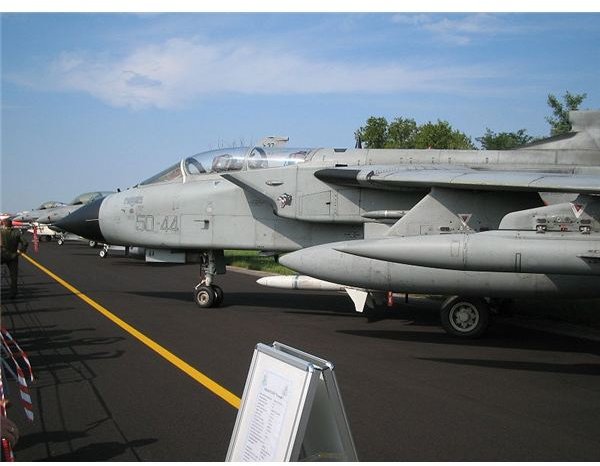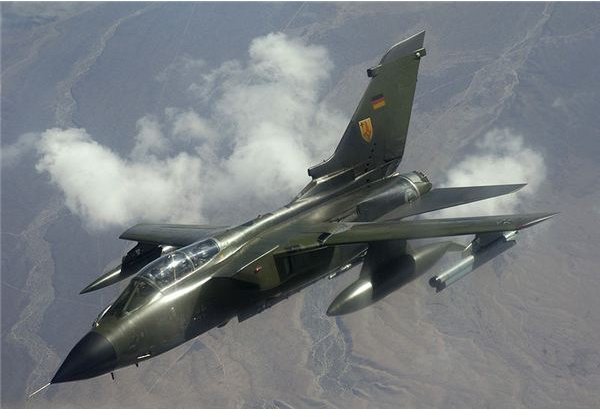The Panavia Tornado Fighter Jet for Europe's Defense
Variable Geometry to Maximize Functionality
The Panavia Tornado was conceived in the late 1960’s and early 1970’s as a powerful strike aircraft capable of flying low and fast in order to avoid opposing air defenses, which by this point of the Cold War were rapidly becoming lethal threats to any aircraft attempting to penetrate enemy airspace at higher altitudes.
The twin requirements that the fighter be both fast and capable of low level flight posed a problem for designers. Typically, aircraft designed to fly at lower altitudes are designed very differently than those that are supposed to operate at higher airspeeds. A variable geometry wing that sweeps forward and back depending on operational needs was selected as the Tornado’s airfoil in order to allow a Panavia Tornado fighter to operate efficiently while performing its assigned mission.
Panavia Tornado - Fighter Design Gone Cooperative
Panavia Tornado fighters are particularly unique due to their design and production being farmed out to each of the three European nations who wished to purchase a next generation strike fighter. It is usually difficult enough for a design bureau or team under the auspices of a single government posing requirements for a new design to meet all the objectives set out for them, but Panavia effectively took the skills and cultures of three separate companies - Alenia Aeronautica of Italy, MBB (a latter day incarnation of the famed Messerschmidt company) and British Aerospace - and conducted a successful design and manufacturing process that brought the Panavia Tornado Fighter into production.
The successful process of creating the Tornado and its many variants can arguably be reflected in the overall success of the Eurofighter design project. It involved all three of the primary Tornado contributors - Italy, Germany, and Britain - while adding Spain in as an equal partner.
Tornado Specs

The Panavia Tornado fighter is a variable geometry design, and so wingspan will change depending on the sweep status of the wings. Figures given when relevant are for the wings in their least-swept orientation.
- 46 foot wingspan, 56 foot length, 59 foot length, 20 feet high
- 31 ton maximum takeoff weight, 15 tons empty
- Two engines with afterburners, mach 2.2 maximum speed
- 70,000 foot service ceiling, over 1500 mile maximum range
- Two crewmembers, variable geometry wings
- One or two 27mm cannons (ADV and IDS versions)
- 3 heavy, eight light hardpoints with total max payload of 10 tons
- Capable of delivering precision ordnance and air to ground missiles
- ADV version capable of firing all NATO air to air missiles
- IDS variant able to mount and fire short range AAMs for self defense
- ECR version capable of performing air defense suppression strikes
Panavia Tornado Jets: Tornado IDS
The IDS variant of the Tornado best serves the original intent of the Panavia Tornado jets’ development project: to provide a high speed, low level interdiction/strike platform capable of penetrating opposing air defenses to reach a target and make out again. The IDS was the most widely produced Tornado variant, and has seen service with the German Luftwaffe and its naval equivalent, Britain’s Royal Air Force, and the Italian Air Force. The IDS Tornado has been employed in combat over the skies of Bosnia and Serbia both during the Balkan Wars of the 1990’s as well as in both incarnations of the Persian Gulf War.
And the IDS has not served without losses. A number have been shot down, some by Iraqi air defenses, others by Iraqi fighters, and sadly still others by friendly fire - usually in the form of the US operated Patriot Missile System of Gulf War I fame. An unfortunate quirk of the Tornado IDS’ design is that it is quite similar in function and design to the Soviet era SU-24 Fencer fighter bomber, which can make friend or foe identification in combat difficult.
Tornado ECR - Armed Reconnaissance and Electronic Warfare
The variant of the Panavia Tornado jets that is least talked about but has ended up playing an equally vital role as the IDS variant is the Tornado ECR. Operated only by Germany and Italy, the Tornado ECR was originally conceived as a dedicated high speed recon platform, but evolved into a specialized SEAD platform - SEAD standing for Suppression of Enemy Air Defenses. The continuous growth of Soviet and Warsaw Pact air defense forces during the 1980’s and their fielding of ever more advanced surface to air missiles made the development of electronic warfare platforms of paramount importance. Panavia Tornado jets, as a platform in widespread use at the time, made for a logical choice in this respect.

Modeled after the ‘Wild Weasel’ aircraft pioneered by the United States during the Vietnam War, Tornado ECR fighters carry anti-radiation missiles that home in on the radar transmissions of search and targeting radars used by surface to air defenses to aim their weapons. Tornado ECRs are also equipped with powerful radar jammers that interfere with the operation of radars that haven’t been destroyed by the anti-radiation missiles. Such aircraft play a critical role in modern air operations, confusing and degrading opposing air defense capabilities in order to allow the primary strike aircraft to reach their targets.
The Final Variant: Tornado ADV
The third and final variant of the Tornado airframe, and one primarily fielded by the Royal Air Force (though Italy and Saudi Arabia fly them as well), is that of the Tornado ADV - Air Defense Variant. As the Tornado project moved forward, the RAF realized that its current interceptor forces were becoming badly outdated and unable to protect the British isles from the growing threat of missile attacks originating from Soviet bombers and submarines operating in the Norwegian Sea. The ADV was intended to function as a high speed, long range interceptor capable of defending British airspace against attack.

Similar in role to the US F-15 Eagle, the Tornado ADV is the only one of the Panavia Tornado jets to have air to air combat as its primary role. Now being replaced in this role by the Eurofighter due to its modernity and the expenses of maintaining too many different airframes, the Tornado ADV thankfully never had to play its intended role, as the Cold War came to an end without Soviet missiles ever crashing down upon Scotland.
Sources:
1969 Sarasota Journal Article: 4 European Nations Plan Massive Military Aircraft
The Great Book of Fighter Planes: Lightbody, Poyer, Cole; Beekman House ISBN 0517035987
Images courtesy of Wiki Commons and are in the public domain.
